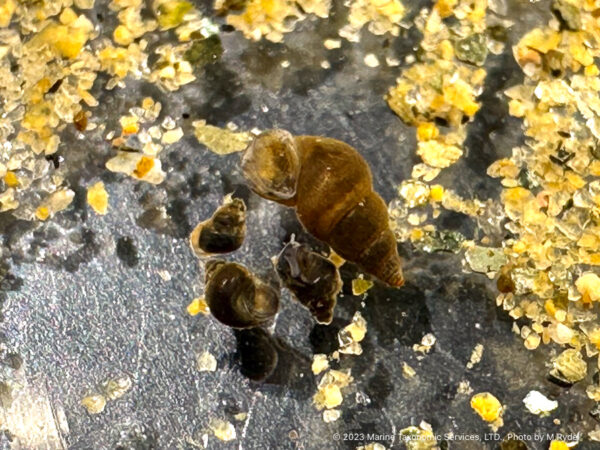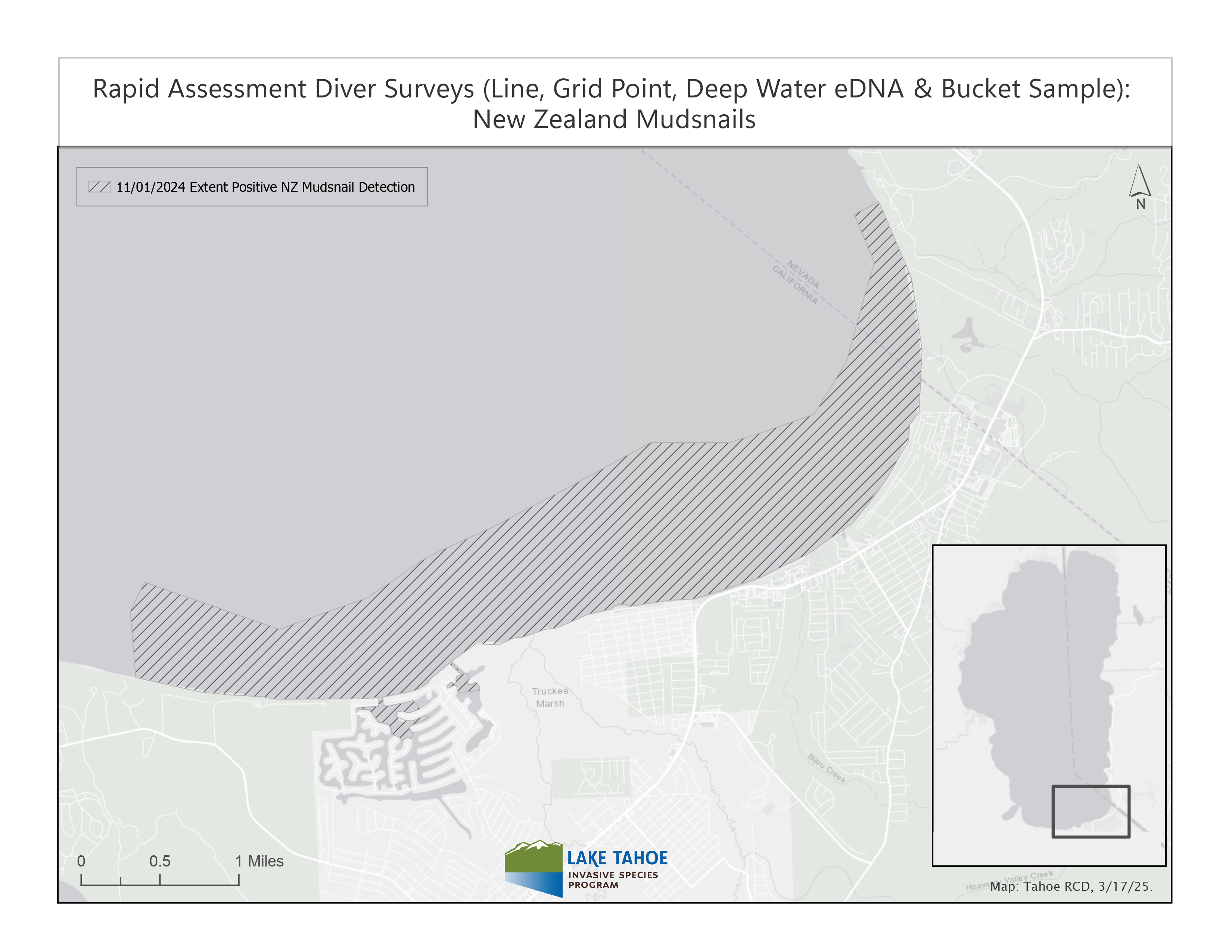New Zealand Mudsnail Information
Divers working under the Lake Tahoe Aquatic Invasive Species Program discovered New Zealand mudsnail in September 2023 in an approximately three-mile area off the South Shore of Lake Tahoe. It was the first time the species has been detected in the Tahoe Basin and the first new invasive species detection since the Watercraft Inspection Program began in 2008.

New Zealand mudsnails found in Lake Tahoe, shown with sand particles from the lake. Credit: Marine Taxonomic Services, Ltd.
Download the free Tahoe Boating App at tahoeboating.org for an interactive map that shows your location relative to the New Zealand mudsnail infestation, as well as no-wake zones, area attractions, bathrooms, and more.
We Need Your Help!
You can help prevent New Zealand mudsnail from spreading to other lakes, streams, and other parts of Lake Tahoe. The number one method to prevent the spread of non-native species is to Clean, Drain, and Dry your vessel and Dispose of any dirt, vegetation, or debris between waterbodies and different launch areas. Specific instructions and requirements are listed below.
Actions for Motorized Boaters
E-foils and electric powered vessels must follow the requirements and recommendations for motorized boaters.
On the Water:
- If possible, temporarily avoid boating in areas of Lake Tahoe known to have New Zealand mudsnails. View map here.
- “Spill where you Fill”: Drain ballast tanks and live wells where you filled them to help your boat, trailer, and to prevent the spread of aquatic invasive species.
- If possible, do not fill any onboard systems (ballasts, fish wells, etc.) in contaminated areas.
- Clean your anchor and line of sediment, vegetation and organisms and dispose of it in the trash before you stow
Exiting the water, these steps are required for launch staff to apply an inspection seal that shows the vessel is clean, drained, and dry:
- Remove drain plugs and drain all water from your vessel.
- Draining of raw water systems should be done .
- If you reach the ramp holding water, ask launch facility staff for the appropriate location to drain.
- Remember, it is the law to have your drain plug removed during transport.
- Lower your outdrive or outboard to fully drain.
- Remove all vegetation from your boat, including the trailer.
Between Launches:
- Clean sea strainers and flush raw water systems (wake boat ballast, live wells, engine, a/c, generators, etc.) to make sure mudsnails aren’t present.
- Dry your vessel for 7 days or more before launching again.
- New Zealand mudsnails are tiny and tenacious. To make sure organisms on your boat are dead, dry your boat for 7 days or more
- A separate inspection and/or decontamination is required to launch in Echo Lake and Fallen Leaf Lake if you were last in Lake Tahoe or another water body.
Actions for Paddlers, Non-Motorized Users, and Beachgoers
Before entering the water:
- Clean, Drain, and Dry your gear before launching at other areas of Lake Tahoe to avoid transporting aquatic invasive species around the lake.
- Visit one of our inspection stations to be inspected and decontaminated for free.
- Non-motorized watercraft are expedited in line.
While on the water:
- If possible, temporarily avoid recreating in areas of Lake Tahoe known to have them. View the map here.
Upon exiting the water:
- Drain all water from your watercraft, toys, and equipment on shore, away from rivers, creeks, storm drains and shorelines beyond the launchpoint.
- Clean your watercraft, toys and equipment of dirt, plants, and debris and dispose of it in the trash. New Zealand mudsnails are often found hiding in mud and vegetation.
- If able, dismantle your paddle to drain and clean inside.
Between outings:
- Dry your vessel and beach toys for 7 days or more before launching again.
- New Zealand mudsnails are tiny and tenacious. To make sure anything on your boat is dead, dry equipment for 7 days or more.
- Echo and Fallen Leaf Lake are free from invasive species found in Lake Tahoe. Thoroughly, Clean, Drain and Dry your vessel, or visit a regional inspection station to be inspected and decontaminated for free.
While at home:
- Become a Tahoe Keeper.
- Watch a 5-minute video and take a brief survey to become a steward of Lake Tahoe.
- Keep your Eyes on the Lake.
- Eyes on the Lake is the League to Save Lake Tahoe’s citizen science program where community volunteers identify and report aquatic invasive plants in and around Tahoe, helping to track and prevent their spread throughout the Lake. To learn more and attend a training visit keeptahoeblue.org.
Actions for Anglers
Before entering the water:
- If you fish from a watercraft, follow the steps above for motorized boaters or non-motorized boaters.
- Never transport live bait. It is illegal in the Tahoe Region to use live bait from waterbodies other than the lake of origin.
- New Zealand mudsnails can survive the digestive systems of fish and can be transported on or in bait.
Upon exiting the water:
- Drain bait buckets.
- Clean, Drain, and Dry gear (fishing equipment, waders, shoes, nets, etc.) as best you can before the next use.
- New Zealand mudsnails can survive for weeks in mud and damp material.
Between locations:
- Avoid going to multiple locations in one day. If possible, temporarily avoid recreating in areas of Lake Tahoe known to have them. View the map here.
- If possible, rotate to additional pairs of boots and waders when moving locations.
- Echo Lake and Fallen Leaf Lake are free from invasive species found in Lake Tahoe. Gear must be thoroughly cleaned and dried between Lake Tahoe and Echo and Fallen Leaf lakes.
While at home:
- Clean and Dry gear
- Gear includes anything that came in contact with water, including nets and waders.
- Take extra care with equipment that came in contact with the lake bottom.
- Clean and Dry clothing
- New Zealand mudsnails are tiny and can attach to clothing, boots, and gear. Make sure to clean felt bottomed boots, shoe laces, tread, and seams.
- Scrub and rinse all boots and waders. If possible, keep additional pairs to rotate and make sure each are fully dried between uses.
- To decontaminate waders and equipment, dry them for 24 hours or more and use one of the following methods:
- Freeze (4 hours@ 26°F)
- Heat (10 minutes in water@ 120°F)
- Bleach (10 minutes in 2.2 tablespoons of household bleach/gallon water)
How these requirements and guidelines prevent the spread of New Zealand mudsnails:
The New Zealand mudsnail is a tiny invasive species, roughly the size of a grain of rice. One single snail can clone itself, producing up to 230 new snails per year.
Research and information gathered by the Tahoe Regional Planning Agency, Tahoe Resource Conservation District, and their partners identified four major vectors for spread:
Mud, Sand and Sediment
- New Zealand mudsnails live in sediment at the bottom of lakes and rivers. In Tahoe, their size makes them hard to tell apart from the sand. Thus, thoroughly cleaning watercraft, equipment and fishing gear of sediment is essential.
- Objects that may come in contact with the bottom of the lake are of special concern, including:
- Anchors, lines, hulls, waders, boots, and trailers.
Water
- New Zealand mudsnails and other invasive species can be transported in water, including ballast tank water. The size of New Zealand mudsnails makes it easy to accidentally draw into water systems.
- New Zealand mudsnails are tenacious creatures, and can survive in damp conditions for 50 days, and dry conditions for 7 days. Thus, completely drying watercraft for 7 days is essential to ensure they are dead.
- Objects that come in contact with water and can hold it are of special concern, including:
- Ballasts, bilges, beach toys, live wells, detachable paddles, storage bags, and buckets.
Plants
- New Zealand mudsnails attach to plants and climb up them to hitch a ride.
- The plants themselves can also be invasive species. Disposing of plant matter prevents the spread of mudsnails and aquatic invasive plants.
- Objects that snag plant material are of special concern, including:
- Trailers, ropes, paddles, propellers, fishing lines, trolling equipment, and nets.
Live Bait
- New Zealand mudsnails can survive in the digestive systems of fish and can be transported on or in bait.
- It is illegal in the Tahoe Region to use live bait from waterbodies other than the lake of origin.

